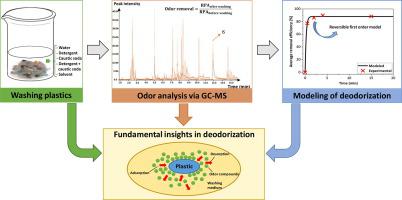Waste Management ( IF 8.1 ) Pub Date : 2020-11-01 , DOI: 10.1016/j.wasman.2020.10.021 Martijn Roosen , Tobias De Somer , Ruben Demets , Sibel Ügdüler , Valérie Meesseman , Bart Van Gorp , Kim Ragaert , Kevin M. Van Geem , Christophe Walgraeve , Ann Dumoulin , Steven De Meester

|
Mechanical recycling is to date the most commonly applied recycling technology. However, mechanical recycling of post-consumer plastics still faces many challenges, such as the presence of odorous constituents. Accordingly, recycling industry is looking for cost-effective solutions to improve the current washing efficiencies. However, scientific literature and basic understanding of deodorization processes are still scarce, which impedes efficient industrial optimization. Therefore, this study aims to obtain more fundamental insights in the deodorization mechanisms of plastic films in different washing media such as water, detergent, caustic soda, and ethyl acetate as organic solvent. The removal efficiencies of 19 odor components with a wide range of physicochemical properties were quantified via GC-MS analysis. The results revealed that deodorization depends on various factors such as temperature and physicochemical properties as polarity, volatility, and molecular weight of the odor components and the washing media. It was shown that polar washing media are less efficient compared to apolar media or media containing a detergent, achieving efficiencies of around 50% and 90%, respectively. The desorption processes can be accurately modeled by the isotherm model of Fritz-Schlunder in combination with a reversible first order kinetic model for the deodorization kinetics. Aspen Plus® process simulations of a water-based washing process reveal that at least 60% fresh water is needed to avoid saturation of the medium and undesired (re-)adsorption of odor components onto the plastics, which results in a substantial ecological footprint.
中文翻译:

更好地理解从消费后塑料薄膜废料中去除异味的动力学研究:不同洗涤介质的除臭效率动力学
迄今为止,机械回收是最常用的回收技术。但是,消费后塑料的机械回收仍然面临许多挑战,例如存在有气味的成分。因此,回收行业正在寻找具有成本效益的解决方案来提高当前的洗涤效率。但是,仍然缺乏科学文献和对除臭工艺的基本理解,这阻碍了有效的工业优化。因此,本研究旨在获得塑料薄膜在不同洗涤介质(如水,洗涤剂,苛性钠和乙酸乙酯作为有机溶剂)中的除臭机理的更基本的见识。通过GC-MS分析对具有多种理化性质的19种气味成分的去除效率进行了定量。结果表明,除臭取决于各种因素,例如温度和理化性质,如极性,挥发性和气味成分和洗涤介质的分子量。结果表明,与非极性介质或含洗涤剂的介质相比,极性洗涤介质的效率较低,分别达到约50%和90%的效率。可以通过Fritz-Schlunder的等温线模型与可逆的一阶动力学模型相结合来对脱臭动力学进行精确建模。基于水洗过程的AspenPlus®过程模拟显示,至少需要60%的淡水,以避免介质饱和以及不希望的(再)气味成分吸附到塑料上,从而导致大量的生态足迹。



























 京公网安备 11010802027423号
京公网安备 11010802027423号